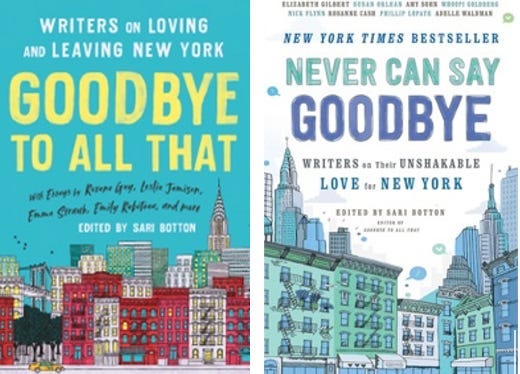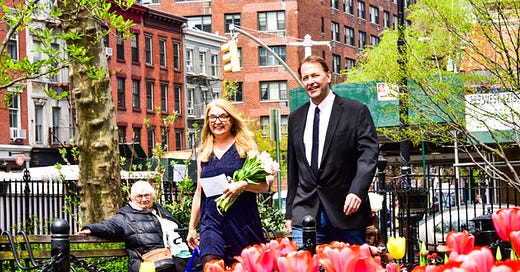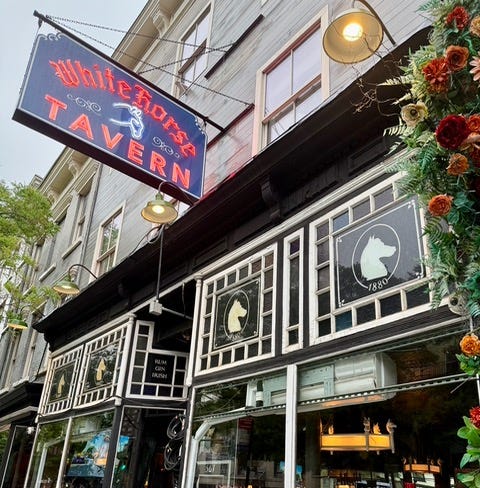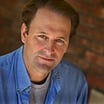You May Ask Yourself...
Michael Ruhlman wonders: How did I get here—a 411-square-foot apartment in Greenwich Village?
I’m a child of the Midwestern suburbs, 1970s Ice-Storm-style suburbs, a land of spacious houses on carpets of grass, shaded by maple and oak and sycamore trees. My home for most of my life. I now live in a 411-square-foot studio apartment in Greenwich Village with my second wife, Ann, and two cats. How did I get here?
I’m a writer of books and articles, the majority about food and cooking and chefs, for which I’ve won three James Beard Awards and a Best American Food Writing Award. But I never set out to be a food writer—I set out to be a novelist. Instead, I am an accidental food writer. And I never set out to live in New York City, a place I had no affection for when I moved there in 1985. In fact, New York City is the absolute last place I thought I’d wind up. And so this question—how did I get here?—leads naturally to another: Do the best things in our lives happen by accident, without a plan? Can we really plan anything at all, let alone the best things?
In 1985, at age 22, despite my aversion to the city, I moved from Cleveland to a railroad flat at 95th and Riverside in Manhattan. I’d landed my first “foot in the door” job as a copy boy at The New York Times. I would be working at the greatest newspaper in the world, living in the world’s greatest city.
In 1985, at age 22, despite my aversion to the city, I moved from Cleveland to a railroad flat at 95th and Riverside in Manhattan. I’d landed my first “foot in the door” job as a copy boy at The New York Times. I would be working at the greatest newspaper in the world, living in the world’s greatest city. Moreover, during the summer, I’d met through a friend the producer of a movie written and directed by David Byrne, the Talking Heads leader who had been a hero to me throughout college. On the basis of my new job at The Times, I’d secured an assignment from culture editor Bill Honan to write a story on Byrne and the movie, True Stories. I would arrive and get set up in New York, then fly to Texas (my own dime) to interview him. I could hardly believe it, David Byrne. An auspicious beginning to a great adventure.
***
Three weeks after I arrived, I found a man in my closet. I said one word to him: “Out.” He complied and I locked the door behind him. Moments later, the man knocked, asking, “Can we talk?” I said, “No, we can’t talk.”
In my room, I saw he’d left without his pants. I used a coat hanger to lift the trousers and throw them out the window.
When I got to the newsroom that night for my 7p.m.-to-3a.m. shift and, still shaken, my colleagues smiled at the story and said, “Welcome to New York!”
That set the tone for my two first years in Manhattan—this place was dangerous. One night during my first weeks there, a copy boy sent out to get the early edition of The New York Post at 42nd and Broadway was knifed and hospitalized; it could just have easily been me. Back then, subways were not only dangerous, they were covered with graffiti inside and out, and strewn with newspaper pages. I would wait up to forty-five minutes in an empty Times Square station for a train home at the end of my shift, terrified. Any place you were alone in New York felt scary.
During the summer, I’d met through a friend the producer of a movie written and directed by David Byrne, the Talking Heads leader who had been a hero to me throughout college. On the basis of my new job at The Times, I’d secured an assignment from culture editor Bill Honan to write a story on Byrne and the movie, True Stories. I would arrive and get set up in New York, then fly to Texas (my own dime) to interview him. I could hardly believe it, David Byrne. An auspicious beginning to a great adventure.
A close friend was mugged at gunpoint returning to his apartment in Brooklyn. The same friend would pick up “a touch of AIDS,” which would kill him. AIDS tore mercilessly through the city in the mid-80s.
In an impossibly expensive city, I was making $15,000 a year. My rent alone ate up half my salary.
Thrilling as it was to work at the center of the world’s news, The Times ultimately felt dispiriting, even degrading. The newsroom was ruthless and competitive. I watched veteran reporters struggling to get their stories in the paper. I heard editors denigrate the writing as they copyedited it. One editor told me my stories were too cerebral. I learned quickly I wasn’t cut out for daily journalism.
***
My only pleasure in New York City was walking the cobbled streets of Greenwich Village, imagining life there when it was new and exciting, teeming with artists. Fanelli Cafe, The Lion’s Head, The White Horse Tavern were the only places I felt at peace because I could live in and love the New York of my imagination.
I dreamed of becoming a writer, a real writer. I lay in the dry fountain of the Plaza Hotel imagining a giddy Scott and Zelda frolicking in the water—exactly here, sixty years earlier. Greenwich Village had been the home of the poet Edna St. Vincent Millay. Blocks away, e.e. cummings wrote his verse, and everyone from Dylan Thomas to Frank O’Hara to James Baldwin drank at The White Horse Tavern. Here was the home of the Beats–Jack Kerouac, Allen Ginsberg, and William Burroughs. Here painters Jackson Pollock, Lee Kasner, Willem de Kooning, and others created the Abstract Expressionist movement.
I could stand at the corner of Bleecker and MacDougal Streets and imagine Bob Dylan and Joan Baez and Jimi Hendrix walking into Cafe Wha?.
Ever in search of that New York, I convinced a friend to have a late afternoon cocktail at the Lion’s Head. It had been the watering hole for great novelists and journalists like Kurt Vonnegut, Pete Hamill, Norman Mailer, and Jimmy Breslin. Now though it was just a normal, famous, old bar.
We sat at the far end of the bar and ordered drinks.
The Greenwich Village I’d dreamed of was still here. But that New York was rarely accessible from my confines in uptown’s nowhereville. After a year, I searched for an apartment in Greenwich Village, but with first month, last month, and security due on signing, I just couldn’t swing the rent. The Times grew increasingly dispiriting. I drank too much, stayed out too late. I made no progress on my novel. I was a cliché. And I was no good at New York.
And then … Kurt Vonnegut walked in and took a stool directly caddy corner to us, right next to us. He ordered a martini and lit a cigarette. I could have reached out and grabbed his arm. I was so gobsmacked to be having a drink beside the author of Breakfast of Champions, all I could muster was, “Mr. Vonnegut, I love your work.” He grinned easily and said thanks. He downed his martini, stubbed out his half-finished cigarette, said, “See ya later,” and was gone. Until that moment I had lived here entirely in my imagination. But Vonnegut was real, right there, next to us. The Greenwich Village I’d dreamed of was still here.
But that New York was rarely accessible from my confines in uptown’s nowhereville. After a year, I searched for an apartment in Greenwich Village, but with first month, last month, and security due on signing, I just couldn’t swing the rent. The Times grew increasingly dispiriting. I drank too much, stayed out too late. I made no progress on my novel. I was a cliché. And I was no good at New York.
***
I quit my job and returned to Shaker Heights to live with my father as I regrouped and worked on my novel. I was grateful to be back home in the leafy comfort of suburban Cleveland, where I would remain for most of the next thirty years, marrying, buying a house in the suburbs I loved, having kids. I loved living here. It was my home, my people. Living where you grew up, I found, gave you great spiritual capital you could regularly tap into; it gave cohesion to this life. My father was here. I could point out to my kids the ballfields where I’d played Little League. My daily jog through the neighborhood took me past my elementary school. Each time I stepped on the cracked sidewalk slab on Fernway Road, the spot Debbie Shaw kissed me in second grade, I thought of her.
Three years later, I got divorced and moved full-time to the pied-a-terre on Labor Day, 2015. I’d moved to this city for the first time exactly 30 years earlier, almost to the day. Here I was again. In a studio apartment the size of my old dining room. “How did this happen?” I wondered, smoking a cigarette on my fire escape. Those first months were hard. I had only three friends in the city. I ate most of my meals alone in the tiny apartment.
At 30, I got my first book contract. And then another. During the next 25 years, I published many more books from my house on the shaded street. I made my living by writing. This writing took me to Manhattan frequently, to work with chefs, to guest judge on Food Network shows, to attend award ceremonies. But I always felt anxious and frayed there—typically sleeping on the couch of a college friend—my heart racing with anxiety for no reason. New York City was not for me. I loved Cleveland. It was my home.
Still, I traveled often enough to Manhattan that in 2012 it made sense for me to buy a pied-a-terre there. If I were bound to return regularly to a city I wasn’t comfortable in, at least I could have my own room, my own perch on the fire escape overlooking West 12th Street in the romantic New York City of my imagination.

Three years later, I got divorced and moved full-time to the pied-a-terre on Labor Day, 2015. I’d moved to this city for the first time exactly 30 years earlier, almost to the day. Here I was again. In a studio apartment the size of my old dining room. “How did this happen?” I wondered, smoking a cigarette on my fire escape. Those first months were hard. I had only three friends in the city. I ate most of my meals alone in the tiny apartment.
But I took comfort in the West Village—because, well, I had no other choice. Now that I used the local Post Office, had a drugstore that filled my prescriptions, knew the cashiers at D’Agostino’s by name, said “Hi” to Paul who took in my dry-cleaning and told me he loved my work, I began to fit into the fabric of the neighborhood.
***
In 2017, I married Ann Hood, a novelist I’d met almost thirty years earlier at a writers’ conference. We would be two writers sharing a tiny apartment (no longer used as just a pied-a-terre) with two cats.

Ann, who’d been living full-time or part-time in Greenwich Village since the early 80s, had mastered the city. She lured me into movie theaters on gray, weekday afternoons. We saw plays at The Cherry Lane and the Lucielle Lortel theaters, just blocks from our apartment. We became regulars in our neighborhood—lunches at Café Cluny, burgers at Corner Bistro, cocktails at Dante, pasta at Anton’s across from The White Horse, a late night patty melt at The Commerce Inn.
We invited our writer friends to cocktail parties in our little place. I met and became friends with authors I admired, novelists and poets and editors. The Mobil gas station around the corner happily and bizarrely made some of the best smash burgers in the city, and we ate them at a picnic table across from the gas pumps.
In 2017, I married Ann Hood, a novelist I’d met almost thirty years earlier at a writers’ conference. We would be two writers sharing a tiny apartment (no longer used as just a pied-a-terre) with two cats. Ann, who’d been living full-time or part-time in Greenwich Village since the early 80s, had mastered the city.
Ann and I walked past Abingdon Square daily: the small triangular park, two blocks from our door, where we’d been married on a sunny April day, tulips in full spring glory. I sometimes saw the musician David Crosby sitting on a bench here, playing his guitar.
Greenwich Village was now, irrevocably, home. I lived in a neighborhood—home to so many artists of the past—in the heart of the great metropolis, and it had become clear that this was to be, and remains, permanent.
***
A few months ago, after seeing I’m Still Here at the Angelika Theater on a weekday afternoon, Ann and I strolled home along storied Bleecker Street, crossing MacDougal, then Sixth Avenue, talking about the movie, then about dinner. Chinese take-out and some news, then into our Murphy bed to read. That sounded heavenly. We had our routine—leisurely hours in bed with coffee as we read The Times, played Spelling Bee, talked about our day ahead; we wrote in the morning; we read in the afternoon; we taught; we cooked dinners, had friends over. I felt so happy—61 years old now, forty years after the man in my closet and two difficult years in this place. Now, how could I live anywhere else? Truly, the greatest city in the world.
How did I get here? I had found the perfect place to live with my perfect person. Or rather, I should say, the best person and the best New York had found me exactly when I needed them. There is no planning. Only intent. Where that intent will lead you, you cannot know.








This is wonderful! Like you, I did a stretch in NYC in the 8Os, and like you, I wasn’t great at it. But I wouldn’t have missed it for anything. I often dream of moving there now, 40 years later and more at ease with who I am. I’m so glad to hear how moving back worked out for you.
This line struck me especially:
“Living where you grew up, I found, gave you great spiritual capital you could regularly tap into.”
And seeing folks you’ve known since childhood, too. Though many are not even friends, when I think of moving away, I don’t know if I could bear to leave them behind.
>>Living where you grew up, I found, gave you great spiritual capital you could regularly tap into; it gave cohesion to this life.
I think about something similar all the time. I had a peripatetic life and now wonder if it's too late to ever belong anywhere. Like Michael, I've settled on the idea that there is no planning, only intent -- things happen, we adjust. Who knows what the future will bring?